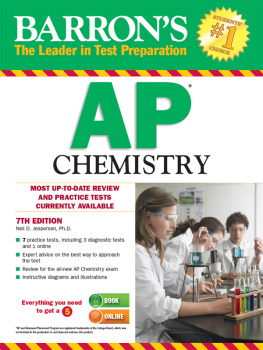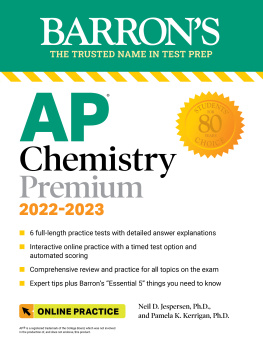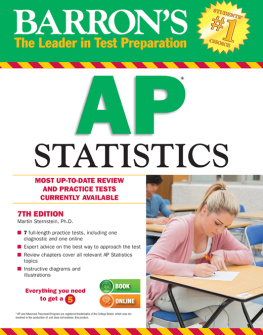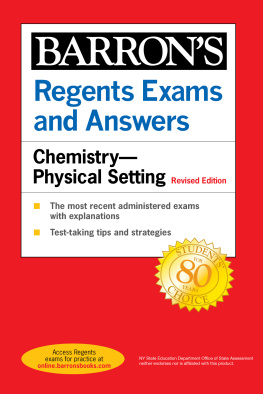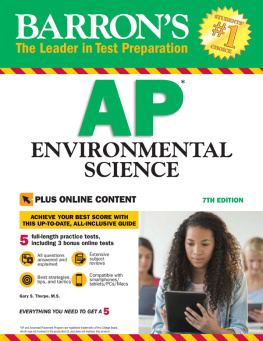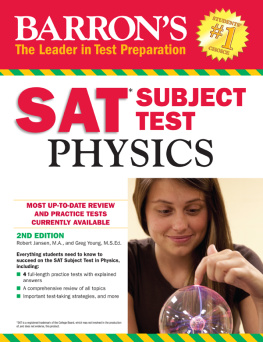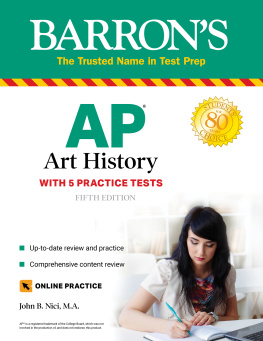Neil D. Jespersen - BARRONS AP Chemistry
Here you can read online Neil D. Jespersen - BARRONS AP Chemistry full text of the book (entire story) in english for free. Download pdf and epub, get meaning, cover and reviews about this ebook. year: 2014, publisher: Barrons Educational Series, genre: Children. Description of the work, (preface) as well as reviews are available. Best literature library LitArk.com created for fans of good reading and offers a wide selection of genres:
Romance novel
Science fiction
Adventure
Detective
Science
History
Home and family
Prose
Art
Politics
Computer
Non-fiction
Religion
Business
Children
Humor
Choose a favorite category and find really read worthwhile books. Enjoy immersion in the world of imagination, feel the emotions of the characters or learn something new for yourself, make an fascinating discovery.
- Book:BARRONS AP Chemistry
- Author:
- Publisher:Barrons Educational Series
- Genre:
- Year:2014
- Rating:5 / 5
- Favourites:Add to favourites
- Your mark:
- 100
- 1
- 2
- 3
- 4
- 5
BARRONS AP Chemistry: summary, description and annotation
We offer to read an annotation, description, summary or preface (depends on what the author of the book "BARRONS AP Chemistry" wrote himself). If you haven't found the necessary information about the book — write in the comments, we will try to find it.
BARRONS AP Chemistry — read online for free the complete book (whole text) full work
Below is the text of the book, divided by pages. System saving the place of the last page read, allows you to conveniently read the book "BARRONS AP Chemistry" online for free, without having to search again every time where you left off. Put a bookmark, and you can go to the page where you finished reading at any time.
Font size:
Interval:
Bookmark:

Now Available!

Go to barronsbooks.com/AP/chem/ to take a free sample AP Chemistry test, complete with answer explanations and automated scoring.
*This online test was created for devices that support Adobe Flash Player. To access the test on an Apple iPad or iPhone you will need to install a web browser that supports Flash (check the iTunes App Store for free options).

Neil D. Jespersen is an active member of the Department of Chemistry at St. Johns University (Queens, New York). He earned his B.S. degree with special attainments in chemistry at Washington and Lee University (Lexington, Virginia) and his Ph.D. at Pennsylvania State University (University Park, Pennsylvania). He specializes in analytical chemistry research and has mentored more than 100 undergraduate research students and 25 graduate students. Dr. Jespersen teaches graduate and undergraduate courses in instrumental analysis and quantitative chemical analysis. He also teaches general chemistry on a regular basis and coordinates the general chemistry laboratory program. Dr. Jespersen is a fellow of the American Chemical Society and currently serves as a councilor from the New York section. He is also the faculty advisor to the ACS Student Chapter at St. Johns University.
Copyright 2014, 2012, 2010, 2007 by Barrons Educational Series, Inc.
Previous editions Copyright 2003, 1999, 1995 by Barrons Educational Series, Inc., under
the title How to Prepare for the AP Chemistry Advanced Placement Examination
All rights reserved.
No part of this publication may be reproduced or distributed in any form or
by any means without the written permission of the copyright owner.
All inquiries should be addressed to:
Barrons Educational Series, Inc.
250 Wireless Boulevard
Hauppauge, New York 11788
www.barronseduc.com
eISBN: 978-1-4380-9264-5
This eBook may appear differently depending on what device you are using to view it on. Tables, graphs, formulas, and math equations may seem not to scale. Please adjust accordingly.
This eBook contains hyperlinks that will help you navigate through content, bring you to helpful resources, and allow you to click between all questions and answers.
As you review the content in this book and work toward earning that on your AP CHEMISTRY exam, here are five things that you MUST know above everything else.
Knowing the basics is universally important. Writing formulas and naming them, writing and balancing chemical equations, counting atoms, and determining molar masses along with proper use of significant figures are the little things that make a big difference between a 4 and a 5! Knowing the basics well also speeds your work so you will seem to have more time for the tough questions. Basic theories of chemistry require an understanding that can be applied to explaining chemical principles. These include the atomic theory, acid-base theories (Arrhenius and Brnsted-Lowry) VSEPR theory, kinetic molecular theory, collision theory, and transition state theory.
Atomic and molecular structures are fundamental to explaining many of the physical and chemical properties of substances. Atomic structure involves electron configurations and helps explain relationships within the periodic table. Molecular structure involves Lewis structures and VSEPR theory to obtain three-dimensional shapes and polarities. Polarity, or the lack of polarity, is the fundamental feature that allows the assessment of the strengths of intermolecular forces of attraction that then allows the explanation of many physical properties.
Stoichiometric calculations are used to solve many AP Chemistry problems. These problems include questions on how much of one substance reacts with another, limiting reactant calculations, titration calculations, and empirical formula calculations.
Principles of chemical kinetics, chemical equilibrium, and thermodynamics are used to explain and/or solve many questions. Chemical kinetics describes what happens as substances react and is used to deduce what happens during a chemical reaction. A dynamic equilibrium is the state that occurs after chemical change has ceased and may be used to determine the extent of reaction or the compostion of the equilibrium mixture. The approaches for kinetics and equilibrium are distinctly different and must not be confused. Thermodynamics explains why chemical reactions occur in terms of changes in potential and kinetic energies. Thermodynamics also provides methods for relating the Gibbs free energy with equilibrium constants and galvanic (voltaic) cell voltages.
Representation and interpretation of the concepts and facts of chemistry is necessary. In todays world, representations are used to explain complex issues and procedures. The new AP Chemistry course embraces this thought. You will find many common chemistry ideas translated to representations of the microscopic, molecular world. Interpretation of data, or evidence, is another skill fostered by the AP course. It is essential that students learn to interpret what they are observing correctly. Reviewing a graph, table of data, or representation of the molecular world and coming to a reasonable conclusion about its meaning is an essential skill in this complex world. These skills will be assessed on the AP Chemistry exam starting in 2014.

Y ou are about to embark on one of the more intellectually challenging experiences of your life, the Advanced Placement Examination in Chemistry. Fewer than 1 percent of all high school students take this exam. Whatever the outcome, you are to be congratulated as one of a select group. As a conscientious student, you can use this review book to help you increase your score. A higher score can lead to college course credit and a head start in your selected career.
The AP Examination in Chemistry is different from other exams and tests that you have taken. Explain , compare , and predict are three important words often used on the AP Chemistry Exam. Remembered facts and calculation procedures are the basic groundwork of chemistry; however, high scores require a thorough understanding of fundamental chemical principles and relationships. Chemistry is rich in these relationships. The key to success on the exam is to think like a chemist and to apply your knowledge of one or more basic principles to provide a logical description of how chemicals behave.
This review book is designed with you, the student, in mind. It concentrates on the topics that are essential for a good score on the AP Chemistry Exam. In particular, the book is designed to provide insights into the use of basic principles to answer seemingly complex questions.
The discussion in each chapter is interspersed with exercises in which subject-matter problems are presented and solved. At the end of each chapter are questions to test your understanding of the topics discussed. These, together with the three diagnostic and three practice tests, provide hundreds of questions with a range of difficulty and complexity typical of an advanced placement exam. Although many questions on the actual exam as well as the practice exams in this book will touch on two or more concepts, the diagnostic test and chapter questions in the book are written mainly as one-concept problems. In this way, the review material will help you to pinpoint weak areas on which you need more preparation, and the explained answers can be used to identify sources of error or confusion.
Font size:
Interval:
Bookmark:
Similar books «BARRONS AP Chemistry»
Look at similar books to BARRONS AP Chemistry. We have selected literature similar in name and meaning in the hope of providing readers with more options to find new, interesting, not yet read works.
Discussion, reviews of the book BARRONS AP Chemistry and just readers' own opinions. Leave your comments, write what you think about the work, its meaning or the main characters. Specify what exactly you liked and what you didn't like, and why you think so.

